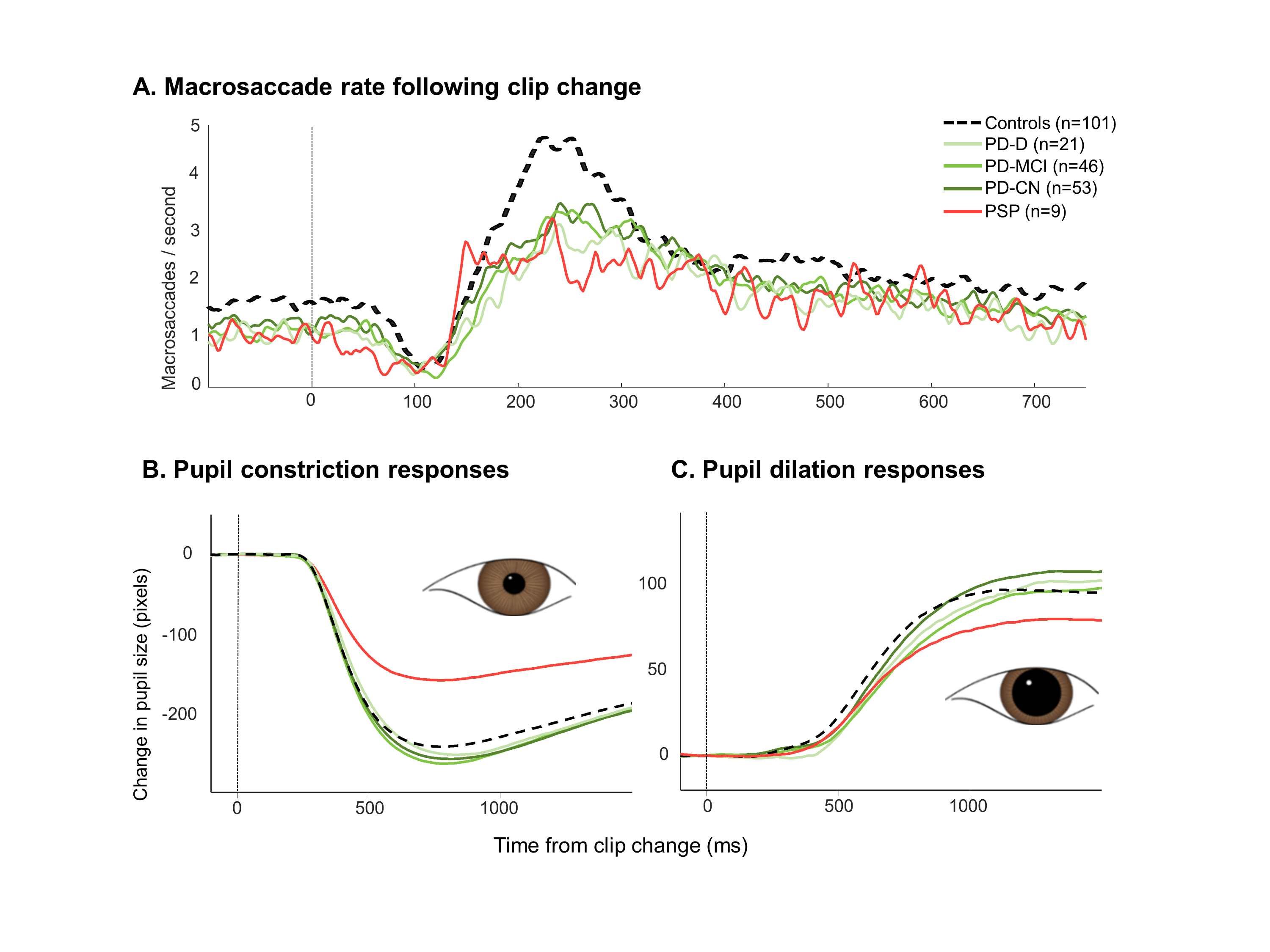Category: Parkinsonism, Others
Objective: Characterize oculomotor phenotypes comprised of saccade, pupil, and blink behaviour for progressive supranuclear palsy (PSP) and Parkinson’s disease (PD) with differing degrees of cognitive impairment.
Background: Differential diagnosis of PD and PSP can be challenging in the early stages and is complicated by the development of dementia in many patients. Objective assessment of saccades, pupil responses, and blinks in non-invasive, rapid eye-tracking tasks may generate parameters that discriminate diagnostic groups and/or dementia severity and could eventually form the foundation of a clinical tool to aid in diagnosis and characterization. Instruction-free tasks are particularly valuable due to their accessibility to cognitively impaired patients.
Method: Healthy controls (n=101), PSP (n=9), and PD (n=120) participants freely viewed rapidly changing video clips while undergoing eye-tracking. The PD cohort was additionally split into levels of cognitive impairment based on an extensive neuropsychological test battery: cognitively normal (PD-CN) (n=53); mild cognitive impairment (PD-MCI) (n=46); dementia (PD-D) (n=21). Saccade, pupil, and blink responses, both across all clips and aligned on clip changes, were quantified and compared between groups.
Results: Low-level saccade parameters (e.g. center bias, overall macro- and microsaccade rate and amplitude) as well as saccade parameters measured relative to clip changes differentiated patient groups from controls. Vertical gaze limitation and increased rate of square-wave jerks were evident in PSP. Pupil constriction and dilation responses appeared attenuated and slightly exaggerated in PSP and PD, respectively. Some parameters (e.g. saccade rate 100-180ms following clip change, blink rate) may scale with cognitive impairment in PD. [figure1]
Conclusion: Free viewing of video clips provides quantifiable oculomotor measures that can differentiate PD, PSP, and controls. Specific parameters may scale with dementia severity. This suggests that instruction-free viewing of video, which is accessible to cognitively impaired patients, may provide a rapid and non-invasive supplement to diagnosis and stratification. Future work should establish oculomotor signatures of other Parkinsonian disorders and investigate modulation by dopaminergic medication and additional clinical features.
To cite this abstract in AMA style:
H. Riek, B. White, D. Brien, B. Coe, C. Fearon, S. Arnott, D. Beaton, M. Binns, S. Black, E. Finger, A. Frank, D. Grimes, A. Lang, W. Lou, C. Marras, M. Masellis, P. Mclaughlin, J. Orange, A. Peltsch, A. Roberts, T. Steeves, K. Sunderland, B. Tan, D. Tang-Wai, C. Tartaglia, D. Munoz. Oculomotor parameters measured during free viewing of video differentiate Parkinson’s disease from progressive supranuclear palsy [abstract]. Mov Disord. 2023; 38 (suppl 1). https://www.mdsabstracts.org/abstract/oculomotor-parameters-measured-during-free-viewing-of-video-differentiate-parkinsons-disease-from-progressive-supranuclear-palsy/. Accessed December 27, 2025.« Back to 2023 International Congress
MDS Abstracts - https://www.mdsabstracts.org/abstract/oculomotor-parameters-measured-during-free-viewing-of-video-differentiate-parkinsons-disease-from-progressive-supranuclear-palsy/

